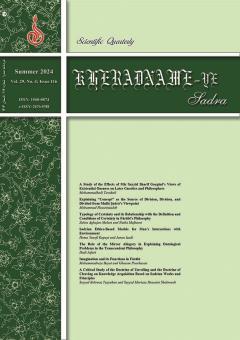The Role of the Mirror Allegory in Explaining Ontological Problems in the Transcendent Philosophy
Subject Areas : Studies on Mulla Sadra and the Transcendent Philosophy
1 - PhD in Transcendent Philosophy, University of Isfahan, Isfahan, Iran
Keywords: Mirror, allegory, Mullā Ṣadrā, reflectivity, accidental affirmation,
Abstract :
Mirror, as an amazing artifact and phenomenon, has always attracted the attention of Muslim thinkers in order to explain gnostic problems. Mullā Ṣadrā’s art in the Transcendent Philosophy was to use the allegory of mirror to explain his own ontological findings. This paper, which is written based on content analysis and library sources, aims to clarify the quality of Mullā Ṣadrā’s use of this allegory in explaining philosophical problems and findings and demonstrates that, in doing so, he mainly resorted to 11 features of mirror in order to explicate several complex philosophical problems including the following: Lack of identity of the existence of forms in the mirror with the existence of the mirror itself despite the existence of forms in the mirror; mirror’s reflectivity; lack of reflectivity because of rustiness; existence of an obstacle between the mirror and the entity, effects of the mirror’s direction and position on observing the external object; the dependent and accidental existence of visible forms in mirror; conformity of forms in the mirror with external objects; inversion of images in the mirror; various potentials of the mirror for receiving light and forms; mirror’s illumination potential; mirror’s not being essentially visible, and strength and weakness in mirror’s reflectivity. These features have resulted in the efficiency of the allegory of mirror in explaining such problems as God’s knowledge of existents, God’s relation to existents, unity of existence despite the plurality of existences, annihilation in God and true worship, God’s proximity to existents, God’s knowledge, the relation between existence and quiddity, the relation between the world and the hereafter, viewing mortal things as beautiful entities, immateriality of perceptive forms, observing the truths, conditions and obstacles of the soul in the perception of the truths, immortality of the people of Hell, problem of intercession, the relationship between the worldly and other-worldly bodies, and the soul-body relationship.
